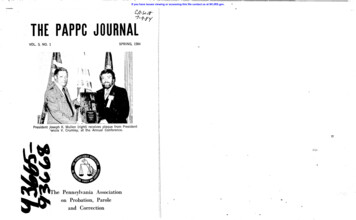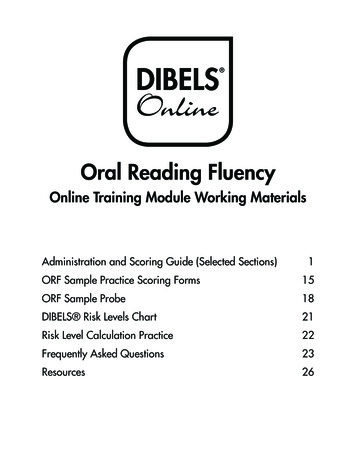
Transcription
If you have issues viewing or accessing this file contact us at NCJRS.gov.C/2-u/f-7-9-r1'THE PAPPC JOURNAL!'Ii!1I:1I'SPRING, 1984VOL. 3, NO.1:1IIIlII'1;\il;jII'iIiII"Ij11IIpPresident Joseph K. Mullen (right) receives plaque from President- ancis V. Crumley, at the Annual Conference.II H'1IIitIII!!!\1IIJ"i\l:111\1\IIII1\II11I,111\he Pennsylvania AssociationIIIiIon Probation, ParoleIand CorrectionI\1
') ,tI1PAPPC 1983-84 EXECUTIVE COMMITTEEPRESIDENT(Term expires 1984)Francis V. CrumleyChief Adult Probation/Parole OfficerBucks County Adult Probation/ParO:A:ePRESIDENT-DESIGNATE(Term expires 1984)Harold M. ShalonDeputy District SupervisorPa. Board of Probation & ParoleLeo J. Lubawy, Jr.FIRST VICE PRESIDENT(Term expires 1984)Parole AgentPa. Board of Probation & ParoleSECOND VICE PRESIDENT Ronald E. Sharp(Term expires 1984)Executive DirectorJuvenile Court Judges' CommissionKathie S. PhelpsSECRETARYProbation/Parole Officer(Term expires 1984)Blair County Adult Probation/ParoleJoseph M. Gambescia, Jr.TREASURER(Term expires 1984)SupervisorPhiladelphia Adult ProbationJoseph K. MullenEX-OFFICIOConsultantInstitute for Juvenile Justice, Trainingand Research;III:!d1,i!I!iIji!: j'IIIII!r!,!:f;/,\' l:1!II Jf,t1,IrII,I!lj;ItI,I1IIIIIfiIi1EXECUTIVE COMMITTEE MEMBER-AT-LARGEDiane L. Dombach(Term expires 1985).Josephine W. .Johns(Term expires 1986)f!I!III}11Delaware Valley Area:Lehigh Valley Area:North Central Area:Northealst Area:Northwest Area:South Central Area:Southeast Area: 'Southwest Area:\Leon O. DarkJill M. BoylanSusan D. EshlemanJohn T. ConlonVincent J. McElhinnyBruce W. GallagherJeffery A. FunkThomas P. Conroy)\'ilIIIIiIII!It!I,Il\ii!IiIIIIAdvertising Representative: AMSHER Corporation431 Shady AvenuePittsburgh, P A 15206IIIH,IIVOLUME 3, NO.1SPRING, 1984RONALD E. SHARP, Editori ijI.The purposes and goals of tne Association are to work towards theadvancement of the methods and standards in the fields ofprobation and parole for adults and juveniles, and in institutionalcare; to promote appropriate legislation; to cooperate with allmovements promoting the progressive treatment and prevention ofdelinquency and crime.IiIAdministrative Assistant to the DeputyCommissionerPa. Bureau of CorrectionDeputy DirectorLancaster Co. Adult Probation/ParoleProgram Development & TreatmentSt. Gabriel's Ha SystemCHAIRMEN OF AREA COUNCILSThe Pennsylvania Association on Probation, Parole,and Correction2149 N. Second St.Harrisburg, PA 17110Joyce S. Dromgold, Administrative Officer)1!David L. Gearhart(Term expires 1984)THE PAPP'C JOURNAL\1I!ItPrinted at the State Correctional InstitutionCorrectional IndustriesHuntingdon, PA 16652Send all manuscripts to the P APPC Office2149 N. Second St., Harrisburg, PA 17110"-.-. J .,.'Q
-----------------------------------------TABLE OF CONTENTS1,IPageEditorial . 1Correction . 2\;lI";;1Justice Department Information . , . 3IIINewspaper Articles . 12From the American Probation and Parole Association . 17IIi!1983 Conference Photos . 231/Ii\til,FEATURE ARTICLES t'V orcrime Victims: The Long Ignored Q;.vLCinderellaby Stephen J. Suknaic . 30 KcorrectionsAnd Criminal Justice: The Model Muddleby James L. Jenge]eski . 50'iJ ail-preventive93665 -68U.S. Department of JusticeNational Institute of JusticeThis document has been reproduced exactly as received from theperson or organization originating it. Points of view orQ i. ;ons stat din this document are those of the authors and do nor-necessarilyrepresent the official position or policies of the National Institute ofJustice.Permission to reproduce this copyrighted materi(\1 has been . granted byPennsylvania Assocl.atl.on onprobation, Parole 9c Correctl.ons . Detentionby James Weiskopff. . 59 riving L-'.Under The Influence: The Law and Enforcementby Marsh U R. Davis . 66Advertisement . 74I,to the National Criminal Justice Reference Service (NCJRS).\Further reproduction outside of the NCJRS system requires permission of the copyright owner.J/
--------------IIITHE PAP PC JOURNAL1EditorialThis issue of the Journal contains several rather provocativeideas. The article by Edward Thibault outlines how you may bespending your time if you are in the "system" ten years fromnow. Megatrends by John Naisbitt is the stimulus for Dr.Thibault's article.Stephen Suknaic's article on crime victims may cause somediscomfort. Each of us knows that we have always been just asconcerned for the victim as we are for the defendant. The federalgovernment's renewed interest in crime victims makes this articletimely and relevant.The article prepared by James Jengeleski outlines the modelswe have used in the justice system. Dr. Jengeleski questions ourmodels and provides considerable data to support his premise thatwe have not yet decided what we want to do to and for the criminal.James Weiskopff's article on Bail-Preventive Detention isboth informative and thought provoking. His discussion of the useof bail in" the juvenile justice system is very timely in light of theSchall v. Martin case before the U.S. Supreme Court and theColeman v. Stanziani case in Pennsylvania.The article on driving under the influence prepared by Marshall Davis continues to explore this emotional and highly politicalissue. Mr. Davis provides an excellent background on the problemof drunk driving. His article contains an overview of national andinternational approaches to the problem and a discussion of Pennsylvania's drunk driving law.As I have noted in the past, publishing articles prepared bypeople in the "system" is the basic goal of this Journal. It is thethinking and thoughtful person in the "system" who will helpbring about needed change. In the conclusion of Megatrends,N aisbitt states:"In a time of change we have extraordinaryleverage and influence - individually, professionally, and institutionally - if we canonly get a clear sense, a clear conception, aclear vision, of the road ahead."Ronald E. SharpEditor\1!II I!!l'IItjIf1)!I1II,IIII'jIiIIIII1\Ir\1ilII 11 1'\!II!qII!tH;'t I\ .I III, !)( .J.
-------- \,i'2THE PAPPC JOURNALCORRECTIONThe Summer 1983, issue of the Journal (Vol. 2, No.2.)contained the following error:REPORT ON THE DEVELOPMENT OFVICTIMjWITNESS SERVICES PROGRAMSBYANDREW J. DeANGELOPAGE 45This past summer, the Lehigh County Juvenile ProbationDepartment had Intern Students personally explain to the victimsthe process that they are involved in. Some of the victimsremembered more details about the incident a few daysafterwards, and told the Intern Students the things theyremembered. This led to additional evidence being compiled. Thestudents were able to alleviate some of the stress and fears that thevictims had. The victims were also genuinely grateful thatsomeone had taken the time to answer their questions and showed.concern about their situation.(The italicized material was omitted from the original printing.)iIIIIIilII "IIIJII!IIjIIIIIII1/I'.l
---- ------- ---------------------- . --.--- 30 THE PAPPCJOURNALTHE PAPPC JOURNAL31-------------------------- ------------CRIME VICT.N\fS:THE LONG IGNORED GINDERELLASUBMITTED BY:STEPHEN J. SUKNAICCHIEF JUVENILE PROBATION OFFICERDAUPHIN COUNTYIntroductionCrime victims, like Cinderella, have been ignored and !orgotten to a gre t extent by th c imi al j?stice system. Th.e crImevictim can be vIewed as the mIssmg lmk m the study of crIme andthe criminal justice system.The purposes of this paper are to:. .1) Briefly review the historical roles of the crime lctIm;2) Discuss traditional views and concepts concernmg thecrime victim;3) Discuss some recent theories of victimology which pertainto victims in the criminal justice system; and4) Draw conclusions and offer recommendations about research and theory related to crime victims.The emphasis in this paper will be on the recent theories ofvictimology which pertain to crime victims. It should be noted thatvictimology, the study of victims, is much broader and encompasses the study of victims of disease, natural disaster , and oth rnon-criminal justice related victims. The reason for thIS emphasIsis that the writer believes that the historical roles, and traditionalviews and concepts concerning the crime victim are somewhatfamiliar to many readers, however, the recently developed heo ries of victimolof::,ry concerning crime victims may not be qUIte sofamiliar to some readers. The information about historical rolesand trarlitional views and concepts are provided to give depth tothis paper, and provide a background for the discussion of victimological theories.Historical Roles Of The Crime VictimIn recent years great interest has been expressed about thecrime victim. To better understand the crime victim it is helpful tohave a. historical perspective of the crime victim's role.Compensation to victims of wrong doing is an ancient tradition. During the earliest history of primitive man private revengeagainst the offender by the offended person was the means of retribution. Since man was alone in his struggle for existence he hadto take the law into his own hands to survive. He was victim, prosecutor, and judge in this solo struggle. 1\As time passed and primitive groups and tri?es wer estai?lished, a crime a.gainst an individual became a crime agamst hISfamily, group, or tribe which exacted revenge on the offender'sfamily or group. This is the origin of the term "Blood-Feud" andthe concept of collective responsibility which became popularamong hunting and gathering soc.ieties in the absence of an independent authority to decide innocence or guilt, and punishment.Nearly all vengeance was made through aggressive physicalattack on the offender and his group based on f&ctors such as: thetype of offense, the status of the offender and offended, the solidarity of the two groups involved in the dispute, the personalanimosity between the two litigants, and the geography separating the two groups.2With the development of material and economic culture thetheft or destruction of property and goods became equated t theinfliction of physical injury. The code of Hammurabi formulatedin approximately the twenty-second century before Christ, and theold Testament of the Bible espoused the philosophy of strict compensation which governed punishment for personal and propertyoffenses.During the middle ages there existed supreme recognition ofthe victim's importance and an emphasis on compensation. This"Golden Age" of the victim's dominant role in the criminal justiceprocess is obvious in the system of "composition", or compensationin the germanic common laws. Composition combined punishmentand damages but could only be applied to personal offenses, notpublic crimes. 3 The objectivity of the germanic laws was an aboutface from the subjectivity inherent in the striving for survivalpracticed by primitive man centuries before with his blood-feud.State intervention gradually increased its influence over composition by claiming a share of the victim's compensation on behalfof the king or ruling lord for achieving a settlement betweenoffender and offended. After the treaty of Verdun in 843 A.D. theFrankish empire was divided and gradually a state fine replacedentirely the composition for the victim. Thus ended the golden ageof the crime victim. The victim lost his once" . almost dictatorialpower over the settlement of the criminal case; at no other time inthe history of crime has the victim occupied such an advantageousposition in criminal procedure."4 Cinderella, in the form of theignored and forgotten crime victim, had evolved.During the latter part of the nineteenth century internationalprison congresses in tockholm (1878), Rome (1885), St. Petersburg (1890), and ParIs (1895) were the forums for the advancement of victim status and victim compensation. However, at thattime, the development of social sciences such as psychology andsociology were being applied with growing interest to the reformof the criminal. This was matched by a decreasing interest in thevictim. 5
----------32\-THE PAPPC JOURNALTHE PAPPC JOURNALThe gradual reemergence of the status of the victim began inthe 1940's with the initial theoretical developments of victimologyintent upon better understanding crime, victim-criminal relationships, and victim problems. A burst of interest and inf rmationabout crime victims took place in the 1970's and was heIghtenedby the influence of the mass media. These developments will bediscussed later in this paper.lishment of victim compensation programs. These are governmentprograms which assume responsibility for providing financialassistance to innocent citizens injured as the result of crime. Thiswas a small but significant move in the direction of victim's rightswhich had been long awaited. 8 Margaret Fry, a British advocateof penal reform, is given great credit for causing the establishment of the first public program of victim compensation whichbegan in New Zealand on January 1, 1964, and was followed by asimilar program in Great Britain later that year. California andNew York were the first states to implement crime victim compensation programs in 1966, and by 1976 there were 29 stateoperated programs. These programs were based on the idea thatcriminal reparation to his victim as part of the rehabilitation process was not always practical, especially when the offender wasimprisoned and unable to make compensation. 9Traditional Views and Issues Concerning The Crime VictimThere exist some widely accepted and traditional views andconcepts concerning the crime victim. Given. the h storic3:1 roles ofthe crime viCtim as a back-drop, the followmg wIll be dIscussed:the twice victimized victim, the victims of "victimless crimes",victim compensation programs, victim-assistance programs,national crime surveys, and victim legislation.It has already been established that the victiw is comparatively ignored by the present criminal justice y tel!l. Worse. th nthat is the wide spread belief that the system VIctimIzes the VIctima second time. In the forward of The Invisible Victim, RobertReiff indicates that he wrote this book to describe the tragedy ofcrime victims. He describes a " . callous post-crime victimization by the police, the courts, the legal profession, and the human service systems of the nation." He accuses society of failing toprotect and aid victims, but instead, oftentimes, ?e :maintain.s thatsociety degrades them socially. He alleges that VIctims are vIewe.das a burden to society and have only themselves to blame for theIrcalamity. Bewildering and absurd rules penalize victims. Perhapsmost importantly Reiff maintains that" . the offender interpretsour indifference to violence and becomes bolder."6There is also controversy concerning the appropriateness ofthe phrase "victimless crimes". Sociologist Edwin Schur. m3;intains that there are indeed victimless crimes such as prostitutIOnand gambling that consist of a consensual transaction and have nodirect victim. Schur suggests changes in the law to legalize suchactivities. However, other theorists, such as Dallin Oaks, believethat victimless crime is nonexistent since family members andloved ones or society in general suffer 'because of these activities.Also, family mem.bers and taxpayers are victimize ?ec use theypay the expensive costs of prosecution and rehabIlItatIve treatment. Oaks also believes that many sex offenses such as adulteryand fornication are legitimate crimes because they pose a severethreat to the basic unit of society, the family.7 This debate againunderscores the disputable role of the victim in the criminaljustice system.After centuries of being ignored a turning point in the treatment of the crime victim took place in the 1960's with the estab-33The "welfare theory" which holds that the government has humanitarian duty to the crime victim similar to its duty to the poor,the sick, the unemployed, and the disabled military veteran alsosupports the concept of public crime victim compensation programs which should not be viewed as a panacea for crime victimssince many shortcomings exist.l o "The major drawbacks to victimcompensation are the costs of the program and legislators' fearsconcerning the possible expense of the program if eligibility forcompensation is not restricted to certain limited situations andindividuals. These concerns for cost have resulted in several majorrestrictions on programs, such as financial need requirements,minimum claims, maximum award limits, and restrictions on thetypes of losses compensated. This latter area contains the almostuniversal restriction against payment for property loss found inexisting programs. The effect that these restrictions may have onthe availability of victim compensation is dramatic. Harland notesthat on a national scale, some 90% of all victims are excluded fromcompensation by the property loss restrictions alone. Of thosequalifying as injured victims of violent crimes, Harland notes thatcurrent restrictions on eligibility would allow compensation foronly 8%."11These eligibility restrictions have caused a unique problemwith the Pennsylvania crime victim compensation program whichis funded from ten dollar fines levied on those who are convictedof, or plead guilty top violent crimes. In the six years since theinception of the program in 1976 it has collected 9 million but 4.7 million of that total has been returned to the general fund atthe end of fiscal years to help balance the budget. The money wentunclaimed due to eligibility restrictions on crime victims. 12 Thisexample illustrates clearly how crime victim compensation programs are only a small step in the direction of victims' rights.
,1\1THE PAPPC JOURNALTHE PAPPC JOURNAL34After the development of crime victim compensation programs, the next advancement on behalf of crime victims was theimplementation of victim/witness assistance programs in the1970's. This advancement was logical since it is obvious that victims need and deserve much more than just financial compensationwhen they venture into the world of the often confusing and inconsiderate criminal court system.The severity of the victim's crisis is usually proportionate. tothe victim's perception of the seriousness of the crime. The crisisreaction is greatly affected by the kind of help the victim receivesin the moments, days, and weeks immediately after the crime.Some people erroneously believe that maturity, strong ch racter,and good mental health should prevent a crime victim from experiencing a crisis. Crime victims who experience a crisis are notweak or immature, but rather are simply reacting in a normal, human manner to a threatening situation. The crisis reaction usuallydevelops in three stages: impact, recoil, and reorganization; andcauses feelings of guilt, shame, alienation, depression, and evendespair in extreme cases. I3Some research indicates that brief psychotherapy can helpalleviate the crisis reaction experienced by victims of violentcrimes such as rape, robbery, and assault. These victims reportedsymptoms such as intrusive thoughts and images, nightmares,negative self-images, fear of repetition of the crime, feelings ofresponsibility for the crime, and discomfort over vulnerabilitywhich were often dealt with successfully in brief psychotherapy.This therapy can also help to prevent chronic pathology which canresult after victimization.1 4In addition to psychotherapy in appropriate cases a vast arrayof victim services should ideally be available to ease -the victim'smovement through the criminal justice system. The following listmay not be all-encompassing but it is intended to give the readeran idea of the type and variety of victim/witness services usuallycoordinated by the prosecutor's office or the probation office:1) General crime victim awareness information to let thegeneral public know that services are available should acrime occur;2) Crisis intervention services to provide immediate care tovictims should be available round the clock includingtelephone hotlines, emergency transportation shelter,food, clothing, counseling and the like;3) Complaint assistance to assist victims who enter thepolice station unaccompained by a police officer to report a1CrIme;\4) Counseling and social services are the logical extensionof the crisis intervention offering therapy and casework35services over an extended period of time as needed;5) Sensitive crimes prosecution is provided in crimes suchas sexual assaults to reduce, if possible, the excessivenumber of times a victim must recount his/her story sothat the victim will be more likely to testify;6) Mediation for victims not interested in the formaljudicial process, but, instead, an out-of-court settlement;7) Restitution which requires the offender to compensatethe victim for losses;8) Property return and repair allows for the promptreturn of recovered stolen property to the victim evenprior to its use as evidence in court;9) Witness information answering basic questions concerning rights and responsibilities of witnesses is of interest to victims since they often must testify as a sworncourt wi tness;10) Victim/Witness notification and management includesefforts to inform victim/witnesses when and Where theyare required to be present and keeping them abreast ofthe status of their cases;11) Victim/Witness protection against threats and retaliation;12) Transportation to proceedings for the elderly, poor, andhandicapped victims and witnesses;13) Separate waiting areas so that prosecution witnessesand victims need not intermingle uncomfortably withwitnesses for the defense and accused offenders;14) Child care for victims and witnesses who must bringtheir small children with them to court;15) Language interpretation so that victims and witnessescan accurately present their testimony;16) Lodging arrangements for out-of-town victims andwitnesses to lninimize their inconvenience;17) Adequate fees for witnesses; and18) Employer intervention so that victims and witnesses arenot unduly penalized by their employer for taking part ina court proceeding which demands time away from employment. I5Another development in the interest of crime victims tookplace in 1972 when the U.S. Bureau of The Census began conducting the national crime survey for the law enforcement assistanceadministration. The national crime survey focuses on certain"personal crimes" of rape, robbery, assault, and larceny, and"household crimes" of burglary, larceny and motor vehicle theft.I t was developed in an effort to obtain more reliable informationon the distribution of crime in American society. Prior to 1972 the
(1ilil:[THE PAPPC JOURNAL'\THE PAPPC JOURNALnation's primary source of crime information was the uniformcrime report compiled by the Federal Bureau of investigation.These annual reports, however, provided limited information concerning crime victims, and widespread concern existed that theuniform crime reports did not accurately show the volume andtypes of crime since only crime known to the police was included. I6Each year the national crime surveys are compjJed by interviewing persons in 60,000 households about their victimizationexperiences. This data is an estimate rather than an actual countsince only a sample of the population is involved in the survey process. These surveys are carefully designed and the degree of erroris considered to be relatively small. One weakness in this surveysystem is that self-reports do not allow homicide data to collected,and another is memory decay and distortion related to the othercrimes surveyed. 17 However, as this survey instrument is refined,it should be helpful in providing more accurate information aboutcrime victims, especially those who do not officially report theirvictimization to the police for a variety of reasons: shame, fear,guilt, etc.Victim legislation will be the final issue discussed in thissection of the paper devoted to widely accepted, traditional viewsand issues concerning the victim of crime. Victim legislation, likethe victim compensation programs, the victim/witnesses assistance programs, and the national crime survey previously discussed is another small, modest step toward the properrecognition of the rights and needs of the crime victim.Given the problems encountered by the Cinderella of thecriminal justice system, effective victim legislation will have tocontain three important elements. First, a victim law must assurethat the innocent victim will receive the same considerations asrequired for the accused. Second, victim compensation from theoffender or the governrnent must be assured in all situations, notjust in the present, limited situations. Third, compensation toinjured, innocent intervenors, or "good samaritans", who come tothe aid of crime victims or police must be assured. This would liftthe psychological inhibitions that sometimes cause a would-beintervenor to remain uninvolved. ISThe Federal Omnibus Victim Protection Bill of 1982 whichwas sponsored by Pennsylvania Senator John Heinz and recentlysigned into law by President Reagan as public law 97-291 appearsto have the three important elements previously mentioned. Itmandates victim impact statements, protection of victims andwitnesses from intimidation, witness relocation and protection forall types of crimes, restitution (unless the judge states for therecord why restitution shall not apply), fair treatment of crimevictims and witnesses, and no profit by a criminal for the sale of11his story. However, many provisions of this act are left to theUnited States Attorney General to implement by introducingadditional legislation which could be a time consuming process. Itis claimed that changes called for in this law do not requireadditional appropriations of federal funds, and, indeed the lawrefer,S to accomplishing" . all that is possible within the limits ofavailable resources . "19 It is naive to believe that these extraresponsibilities can be completed without extra funding. If thislegislation is adopto,d by the various states, as intended, it isnecessary that sta. .s allocate needed funds for practical implementation or we will have only the appearance of victim paritywith the accused.This section of the paper has described some widely knownvictim concepts such as the forgotten victim who is victimizedtwice, and victimless crime. Public victim compensation programs, victim/witness assistance programs, national crimesurveys, and model victim legislation have all been discussed anddescribed as small, modest steps towards the proper recognition of,and service for, the crime victim. In the discussion of their shortcomings it is obvious they are not panaceas, and a great deal stillneeds to be accomplished to understand the role of the victim andhis needs, and the implementation of long awaited victim serviceswithout red tape, eligibility restrictions, and time delays.36IIit'\1!'I!"III\j137The Recent Genesis of VictimologyThe remainder of this paper will be devoted to a descriptionand discussion of the recent, innovative, and sometimes controversial concepts and theories of victimology. There is controversyeven about the definition and scope of victimology. BenjaminMendolsohn, the Rumanian criminologist and one of the pioneersof victimology, maintains that to limit victimology only to thestudy of crime victims, instead of to all victims, reflects a narrowapproach and relegates it to an auxiliary position in relation tocriminology. Mendelsohn asserts that man can be the victim of acriminal; the victim of himself; the victim of anti-social behavior;the victim of technology; and the victim of his natural environment. He believes that victimology is that broad in scope, and,indeed, that is the official position of the International Society ofVictimology as evidenced by the breadth of its interests andarticles published in Victimology: An International Journal,its professional publication. 20Others view victimology in a narrow, restrictive manner as abranch of criminology studying only the victims of crime. Thisposition is based on the facts that contributions to victimologyhave been introduced by criminologists, and that victimology isstill in its infancy and has not yet developed into a separate aca-
/I38THE PAPPC JOURNALTH.E PAPPC JOURNALVictim vulnerability, or proneness, simply means that certaintypes of people are more susceptible to crime than others. HansVon Hentig was the first to thoroughly list, describe, and discussthese types as follows: the young, the female, the elderly, themental defective, the immigrant, the minority, the depressed, thewanton, the lonesome, and the heartbroken. 24 The teenager, thehomosexual, and the prison inmate have been added to Hentig'soriginal list in recent years by other theorists and shall also beincluded in the discussion.demic discipline. These theorists view victimology as a branch ofcriminology.2l With that debate in mind it is sufficient to state thatdiscussion in this paper will be limited to victims of crime invictimology.Criminology, as a field of study, is a recently developed discipline born approximately a century ago and built on offendercentered and offender-related research and theory.Victimology isa body of knowledge developed over the past decades which is builton victim-centered and victim-related research and theory. Bothdisciplines have basic goals of understanding crime and its participants, and reducing the occurrence of crime. Victim researchhas the potential to bring about a balance to criminological research.While most countries, including the United
ANDREW J. DeANGELO PAGE 45 This past summer, the Lehigh County Juvenile Probation Department had Intern Students personally explain to the victims the process that they are involved in. Some of the victims remembered more details about the incident a few days afterwards, and told the Intern Students the things they











